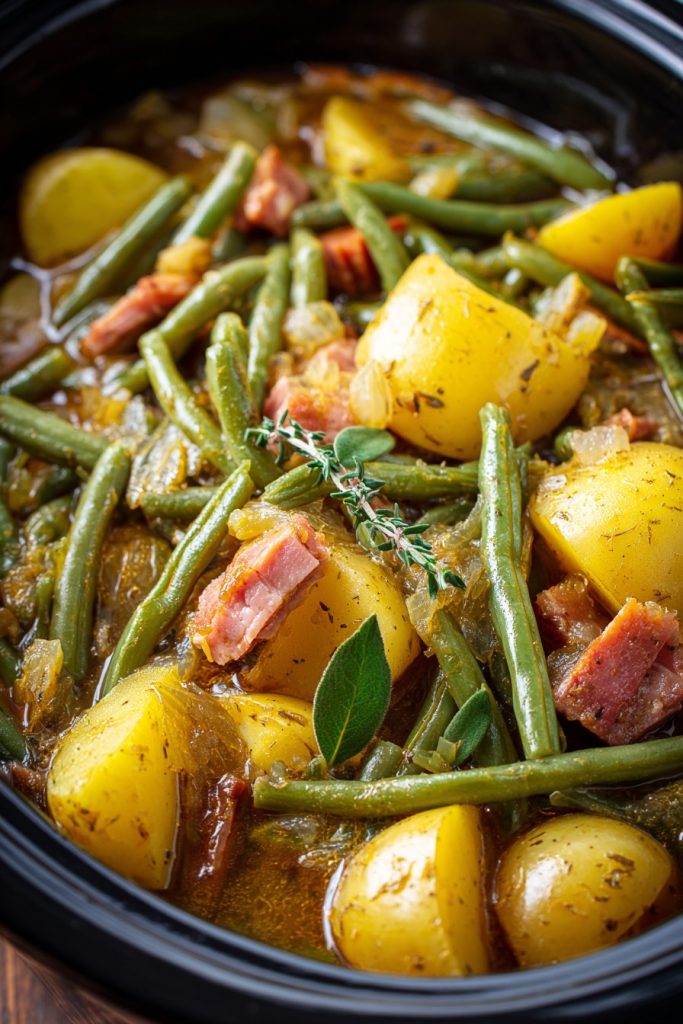Zesty autumn afternoons always take me back to my grandmother’s farmhouse kitchen, where the scent of slow-simmered vegetables would drift through the screen door and welcome us home from school. This crockpot green beans and potatoes recipe captures that very essence of rustic comfort, transforming humble garden ingredients into a dish that feels like a warm embrace from generations past. It’s the kind of meal that makes you want to pull up a wooden chair and stay awhile.
Why This Recipe Works
- The slow cooker method coaxes out the natural sweetness of the vegetables while preserving their nutrients, creating a depth of flavor that quick cooking simply can’t achieve
- Layering the ingredients properly ensures the potatoes cook through evenly without becoming mushy while the green beans maintain just the right amount of bite
- Using chicken broth instead of water infuses every vegetable with rich, savory notes that transform this simple dish into something truly special
- The addition of smoked ham hock or bacon provides a smoky undertone that complements the earthiness of the vegetables perfectly
- This hands-off approach means you can tend to other farm chores or simply enjoy the afternoon while your supper practically cooks itself
Ingredients
- 2 pounds fresh green beans, washed and ends trimmed
- 3 pounds Yukon Gold potatoes, scrubbed and quartered
- 1 large yellow onion, roughly chopped
- 4 cloves garlic, minced
- 1 smoked ham hock or 6 slices thick-cut bacon, chopped
- 4 cups chicken broth
- 2 tablespoons unsalted butter
- 1 teaspoon black pepper
- 1/2 teaspoon salt (adjust to taste)
- 1 teaspoon dried thyme
- 2 bay leaves
Equipment Needed
- 6-quart or larger slow cooker
- Cutting board
- Chef’s knife
- Measuring cups and spoons
- Large mixing bowl
- Wooden spoon
Instructions

Prepare Your Vegetables with Care
Begin by giving your green beans a good rinse under cool running water, just like Grandma used to do at her farmhouse sink. Take your time trimming the ends—there’s something meditative about this simple task that connects you to generations of home cooks who prepared their harvest this way. For the potatoes, scrub them thoroughly with a vegetable brush until the skins are clean but still intact; those potato skins add wonderful texture and nutrients to the final dish. Quarter your Yukon Gold potatoes into evenly-sized pieces, aiming for chunks about 1 to 1 1/2 inches thick—this ensures they’ll cook through at the same rate as your green beans. Chop your onion into rustic, uneven pieces rather than perfect dice; we’re going for home-style charm here, not restaurant precision. Tip: If your green beans are particularly long, you might want to snap or cut them in half for easier serving later.
Layer Ingredients Thoughtfully
Now comes the secret to perfect slow cooker dishes: proper layering. Start by placing your chopped onion and minced garlic at the very bottom of your crockpot—these aromatics will perfume the entire dish as they cook. Next, arrange your quartered potatoes in an even layer over the onions, taking care not to pack them too tightly so the heat can circulate properly. Scatter your prepared green beans over the potatoes, letting them tumble in naturally rather than arranging them meticulously. If you’re using chopped bacon, scatter it evenly over the green beans now; if using a ham hock, nestle it right in the center where it can flavor everything around it. This careful layering ensures that the potatoes, which take longest to cook, are closest to the heat source while the more delicate green beans steam gently above.
Add Liquids and Seasonings
Pour your chicken broth slowly over the layered vegetables, watching as it seeps down through the green beans and potatoes to reach the onions waiting below. The broth should come about three-quarters of the way up the vegetables—if needed, you can add a bit more broth or water to reach this level. Dot the surface with small pieces of your unsalted butter, which will melt into the broth and add a lovely richness to the cooking liquid. Now sprinkle the black pepper, salt, dried thyme, and tuck those two bay leaves into different spots so their herbal essence distributes evenly throughout the dish. Resist the temptation to stir everything at this point—trust the process and let the slow cooker work its magic without disturbance.
Cook Low and Slow
Place the lid securely on your slow cooker and set it to cook on LOW heat for 6 to 7 hours. This extended cooking time allows the flavors to develop fully and the potatoes to become perfectly tender without turning mushy. About halfway through the cooking time, you can gently push the top layer of green beans down into the broth if they’re not fully submerged—but avoid vigorous stirring that might break up the potatoes. The dish is ready when the potatoes are fork-tender all the way through and the green beans have softened but still retain a pleasant texture. Tip: If you’re short on time, you can cook on HIGH for 3 to 4 hours, but the low-and-slow method really does yield superior flavor and texture.
Finish and Serve with Love
Once your cooking time is complete, carefully remove the bay leaves and the ham hock if you used one. If using a ham hock, let it cool slightly before pulling the meat from the bone and stirring it back into the vegetable mixture. Give everything one final gentle stir to combine the flavors, being mindful not to break up the potatoes too much. Taste and adjust seasoning if needed—you might want to add another pinch of salt or pepper at this stage. Ladle the green beans and potatoes into deep bowls, making sure to include plenty of that flavorful cooking liquid. Tip: For an extra touch of comfort, serve with thick slices of crusty bread for dipping into that delicious broth.
Tips and Tricks
If you find yourself with an abundance of garden-fresh green beans, this recipe freezes beautifully—just portion the cooled dish into freezer-safe containers and it’ll keep for up to three months. When reheating from frozen, let it thaw overnight in the refrigerator before warming gently on the stove top to preserve the texture of the vegetables. For those who prefer their green beans with more bite, you can add them during the last two hours of cooking rather than at the beginning—this little adjustment makes a world of difference in texture. If your potatoes seem to be cooking faster than your green beans, try cutting the potatoes slightly larger next time or using a variety that holds its shape well during long cooking, like red potatoes or fingerlings. When summer gardens are overflowing, feel free to add other vegetables to the mix—sliced carrots, fresh corn cut from the cob, or even some chopped celery can make wonderful additions that celebrate the season’s bounty. For a creamier version, during the last thirty minutes of cooking, stir in half a cup of heavy cream or whole milk and let it warm through gently—this creates a luxurious sauce that coats the vegetables beautifully. If you’re watching your sodium intake, you can use low-sodium chicken broth and reduce or omit the added salt—the natural flavors of the vegetables and smoked meat will still provide plenty of taste. Don’t discard that flavorful cooking liquid after serving—it makes an excellent base for soups or can be used to cook rice or grains, infusing them with all those wonderful vegetable and herb notes.
Recipe Variations
- For a vegetarian version that still delivers deep flavor, omit the ham hock or bacon and use vegetable broth instead of chicken broth. Add a tablespoon of soy sauce or tamari to the cooking liquid to provide that umami depth you’d normally get from the smoked meat, and consider including a few dried mushrooms for extra savory notes.
- Turn this side dish into a complete meal by adding smoked sausage or kielbasa during the last hour of cooking—slice it into coins and let it heat through gently in the flavorful broth. Serve with a simple green salad and some cornbread for a satisfying supper that requires minimal additional effort.
- Embrace different potato varieties based on what’s available seasonally—red potatoes hold their shape beautifully, sweet potatoes add a lovely sweetness that contrasts nicely with the green beans, or even purple potatoes make for a stunning presentation that will have everyone reaching for seconds.
- For an herbed version that celebrates summer gardens, replace the dried thyme with a bouquet garni of fresh herbs—tie together several sprigs of fresh thyme, parsley, and a bay leaf with kitchen twine and remove before serving. You could also stir in a handful of chopped fresh parsley or chives right before serving for a burst of fresh flavor.
- Create a creamy, indulgent version perfect for holiday tables by stirring in a can of cream of mushroom soup during the last hour of cooking and topping with French fried onions during the final thirty minutes. This variation transforms the humble ingredients into something truly special worthy of any celebration.
Frequently Asked Questions
Can I use frozen green beans instead of fresh?
Absolutely, frozen green beans work wonderfully in this recipe and can be a real time-saver during busier seasons. There’s no need to thaw them first—just add the frozen green beans directly to the slow cooker along with the other ingredients. You may find that frozen beans release a bit more liquid during cooking, so you might want to reduce the chicken broth by about half a cup to compensate. The texture will be slightly different than fresh beans—typically a bit softer—but still delicious. Many grandmothers actually preferred frozen beans during winter months when fresh weren’t available, so you’re in good company using this convenient alternative.
How do I know when the potatoes are properly cooked?
The best test for potato doneness is the fork test—insert a fork into the center of one of the larger potato pieces; it should slide in easily with little resistance. The potatoes should be tender all the way through but still hold their shape rather than falling apart completely. If you find the potatoes need more time but the green beans are becoming too soft, you can carefully remove the green beans with a slotted spoon, continue cooking the potatoes for another thirty minutes to an hour, then return the green beans to warm through before serving. Different potato varieties cook at slightly different rates, so Yukon Golds typically take the full 6-7 hours on low to reach perfect tenderness.
Can I make this recipe ahead of time?
This dish actually improves when made ahead of time, as the flavors continue to meld and develop as it sits. You can prepare it completely up to two days in advance—store it covered in the refrigerator and reheat gently on the stove top or in the slow cooker on warm setting. If reheating on the stove, do so over medium-low heat and stir occasionally to prevent sticking. The vegetables may soften a bit more upon reheating, but the flavor will be even more developed and delicious. This make-ahead quality makes it perfect for potlucks, family gatherings, or simply for having comforting meals ready during busy weeks.
What’s the best way to store leftovers?
Leftovers should be cooled completely before transferring to airtight containers—they’ll keep in the refrigerator for up to four days. When reheating, I prefer the stove top method over microwave, as it allows for more even warming and better texture preservation. Simply place the desired amount in a saucepan with a splash of water or additional broth to prevent sticking, and heat over medium-low, stirring occasionally, until warmed through. The potatoes may absorb some of the liquid during storage, so don’t be alarmed if it seems thicker—just add a bit more broth when reheating to return it to your preferred consistency.
Can I add other vegetables to this recipe?
Certainly! This recipe is wonderfully adaptable to whatever vegetables you have on hand or what’s in season. Sliced carrots add beautiful color and sweetness, corn cut fresh from the cob brings summer sunshine to the dish, and chopped celery contributes additional aromatic depth. Root vegetables like parsnips or turnips work beautifully alongside the potatoes, while mushrooms can add earthiness. The key is to consider cooking times—harder vegetables should be added at the beginning with the potatoes, while more delicate additions like fresh tomatoes or zucchini are better added during the last hour of cooking. Don’t be afraid to make this recipe your own family tradition by including your garden’s bounty.
Summary
This crockpot green beans and potatoes recipe embodies the very heart of rustic comfort cooking, transforming simple ingredients into a nourishing dish that feels like coming home. With its hands-off preparation and deeply developed flavors, it’s the perfect meal for busy days when you still want something truly special on the table.
Crockpot Green Beans and Potatoes
6
servings20
minutes6
minutesIngredients
Instructions
- 1 Prepare vegetables by washing green beans and trimming ends, scrubbing and quartering potatoes, and chopping onion.
- 2 Layer ingredients in slow cooker: onions and garlic first, then potatoes, then green beans, then meat.
- 3 Add chicken broth, dot with butter, and sprinkle with seasonings including bay leaves.
- 4 Cook on LOW for 6-7 hours until potatoes are fork-tender.
- 5 Remove bay leaves and ham hock (if using), shred meat from hock and return to pot, stir gently and serve.



